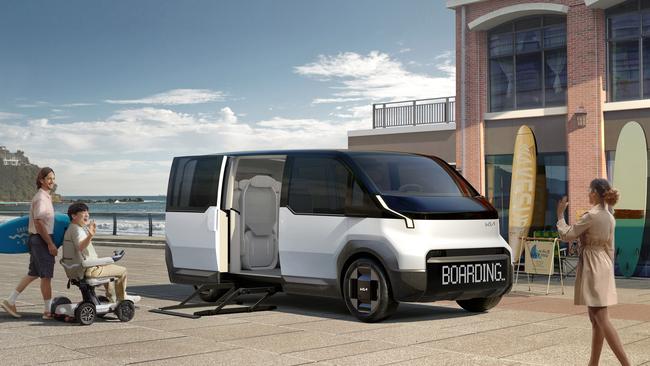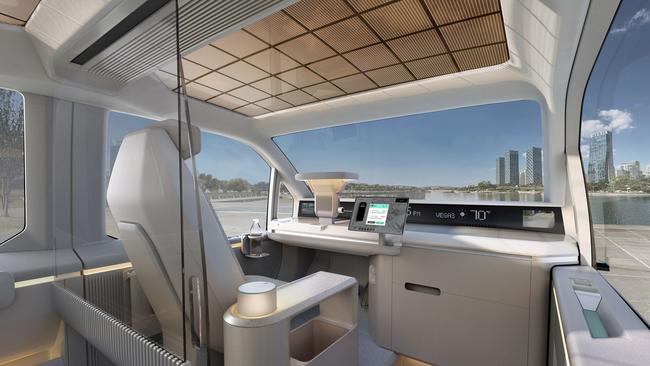Is it a cinema? Is it a plane? Welcome to the car of the future
Look forward to cars that not only do the driving – or even flying – but also offer cinema-like entertainment to while away the journey, plus so much more.

Remember when in-car entertainment meant spending an hour respooling the magnetic tape onto a cassette with a pencil because your car stereo had chewed it up and spat it out again? And when, after much deep breathing and light swearing, you’d finally get The Eagles playing again, only you could barely hear it as you drove with the windows down because airconditioning wasn’t a thing yet?
Or perhaps you recall having a boot that resembled a bombmaker’s lab, with kilometres of loose wiring connecting subwoofers to amplifiers and CD stackers, all constructed to turn your vehicle into one of those shaking earth compactors every time you gave the volume dial a good crank.
Cars of today are floaty pleasure palaces by comparison, but the cars of tomorrow will stretch the gap even further, making even those of us driving the most advanced vehicles feel as though we’ve been manoeuvring Fred Flintstone’s Cavemobile. They’ll be less like cars and more like lounge rooms on wheels (maybe even in the sky). The act of actually driving them will take a back seat, and high-definition TV screens will become more important than windscreens.
A move towards allowing us to increase our screen time to all the time is perhaps the most obvious, but the need for car companies to differentiate themselves from one another in a crowded market is such that surprising innovations are also popping up.
Already this year we’ve seen Hyundai launch the new Santa Fe with a UV-C sterilisation tray. This small compartment above the glovebox uses ultraviolet light to sterilise your mobile phone, wallet or even a child’s toy. Did anyone ask for that? I doubt anyone ever even thought of it.
Here are some of the motoring innovations that are coming down the road, and coming fast.
The full self-driving experience
Tesla has been telling us for years that its cars will be able to drive themselves and is now selling us cars with a system called Autopilot that, surprisingly, actually requires quite a bit of human input. Now it looks like the real deal is actually happening.
While it’s still to be approved for use on Australian roads, customers in the US can pay a $US99 ($146) monthly subscription fee for FSD (Full Self-Driving), which takes you point to point through cities or across the country without the driver needing to touch the steering wheel or pedals. The Tesla website does state, however, the vehicle must remain “under your active supervision”.

And that’s just the beginning: Tesla is also planning to launch its CyberCab, a specially designed model that can go out on its own, earning money for you as a “robotaxi” while you sit on your couch at home and catch up on Netflix.
Audi has also pledged to have a fully autonomous SUV, likely to be called the Audi Q9, in showrooms by 2025. A concept car on which the Q9 is said to be based, called the Grandsphere, was filled with screens but had no visible steering wheel – although one would fold out from the dash if you wanted one.
Self-driving taxis are impressive, and they’re already in operation in the US cities of San Francisco and Phoenix through a Google-owned company called Waymo. But with traffic only getting worse at ground level (something autonomous taxis are not going to help), maybe it’s time we take to the skies.
Hyundai has shown off its first flying vehicle, the Supernal S-A2. Able to take off and land vertically like a very small helicopter, and resembling a large and futuristic drone, Hyundai says it is the prototype for an air taxi that will be in the sky by 2028.
Check out other articles on high-tech The List: Innovators 2024,
Hisense is a television and appliance maker, not a car manufacturer, but as the worlds of transport and TV collide, it is clearly keen to get into the market, recently showing off its laser TV in-car technology at the Consumer Electronics Show in Las Vegas.
Described as “basically a drive-in movie theatre built into your car”, it incorporates a laser projector in the front bumper, allowing you to project movies from your car onto any flat surface, such as your garage door. (Audi already offers a similar style of technology via its Digital Matrix LED headlights, which can project light shows onto walls.) Inside the Hisense concept car, the company also revealed augmented-reality tech that can turn a windshield into an information hub, allowing you to overlay virtual images on the real environment.
If you’d like your entertainment on the go with a side of first-class luxury, new Chinese brand Zeekr has the answer. Its four-seat 009 Grand, a version of its electric people-mover, offers a Gold Class-like experience on the move. A huge 43-inch screen for rear passengers is made from the same (very expensive) glass as the new iPad, and is paired with a 31-speaker Yamaha audio system. A pair of recliner seats with 25-way adjustment are modelled on the legendary Eames armchair and there’s a hot-stone massage function for your feet. There’s even an on-board 18-litre fridge.
Purpose-built vehicles? Pfft. Designing a car, SUV or van to perform just one defined job for its entire life could become a thing of the past if Kia’s PV1, PV5 and PV7 concepts catch on. Its Platform Beyond Vehicle (PBV) electric vans can be customised to move people or products, for car sharing, to become work or living spaces, or even operate as pop-up stores.
They’re designed to be fully autonomous, but it is the seemingly endless ability to reconfigure them at will, and how cute they are, that makes them look and feel a bit like Lego cars.
“Kia PBVs will initiate a new era of seamless everyday business and lifestyle solutions,” says Kia design boss Karim Habib. “We hope to make our customers’ lives easier and better, whether they’re stationary or on the move, offering exceptional flexibility and customisation through radical modularisation.”

Extroverts will rejoice in BMW’s i Vision Dee concept car, which lifts the interactivity between you, your car and other road users to new levels. It’s a compact electric sedan with an exterior made of high-tech material that can change colours and project patterns, allowing it to communicate with its driver, as well as pedestrians and other road users.
The secret to this chameleon-like exterior is BMW’s E Ink technology, comprising 240 individually controlled segments that can instantly switch between 32 colours to make patterns and other visual schemes. As well as being a psychedelic colour changer, Dee takes the concept of AI-controlled voice assistants, like Siri and Alexa, to an entirely new extreme.
Not only will it greet you with a pair of animated eyes in its front grille, but it can talk to you and even learn your behaviour and preferences. Think of it as
a digital co-pilot or – if you’re old enough to remember – your very own version of KITT from Knightrider.

We’ve all felt the sweaty-palmed pressure that comes with parallel parking in a particularly tight spot – usually on a hill, with strangers staring – but that scenario could be banished forever thanks to the Hyundai Mobion concept. It looks like a regular Hyundai Ioniq 5, but underneath it deploys a cutting edge e-corner system for its wheels. That means it not only drives in all the same directions as other cars, but also sideways, so you can slip into that super-tight park with ease.
The system, which is a concept from Hyundai parts supplier Mobis, allows all four wheels to turn independently within their wheel wells, lending the car the same kind of liquid movement as Ricky Martin’s hips. As well as moving sideways, it can crab-walk diagonally, rotate on its own axis, or twist the rear axle only to imitate a perfect handbrake turn. And that, as we all know, is the most impressive thing you can ever do in a car.
Your next car Is a barbecue
Well, maybe not an actual Weber, but you’ll be able to refuel it in much the same way you do your trusty backyard grill. Chinese brand Nio is one of several companies tackling the issue of inadequate public charging infrastructure for EVs – especially for anyone living in an apartment and/or without access to a home charger – by removing charging from the equation altogether.
The brand has launched a battery swap system, in which you pull into a service bay in your almost-flat EV and the battery is autonomously swapped for a fully charged unit, sending you on your way in less than five minutes. You don’t even need to get out.
Think of the swap bay as similar to an automated car wash. You drive in until a light tells you to stop then robotic magic occurs beneath your car as your spent battery is neatly extracted and swapped for a freshly recharged one. You’re on your way in no time at all, and the old battery is recharged for its next use. Just like a barbecue gas cylinder.
It’s not just convenience that Nio is selling. The battery is the most expensive part of an EV purchase, and a swap system means you never actually need to purchase it. Instead, you subscribe to the service for as long as you keep your car. Just as importantly, you never have to worry about your battery becoming old and degraded, which is currently one of the most challenging issues when it comes time to sell an existing EV.


